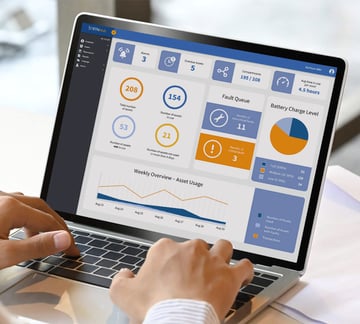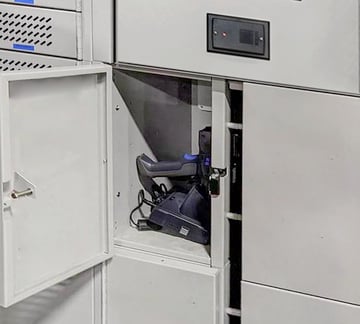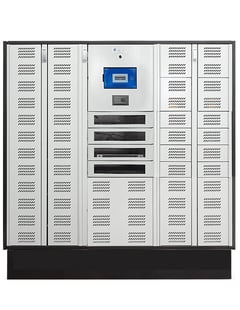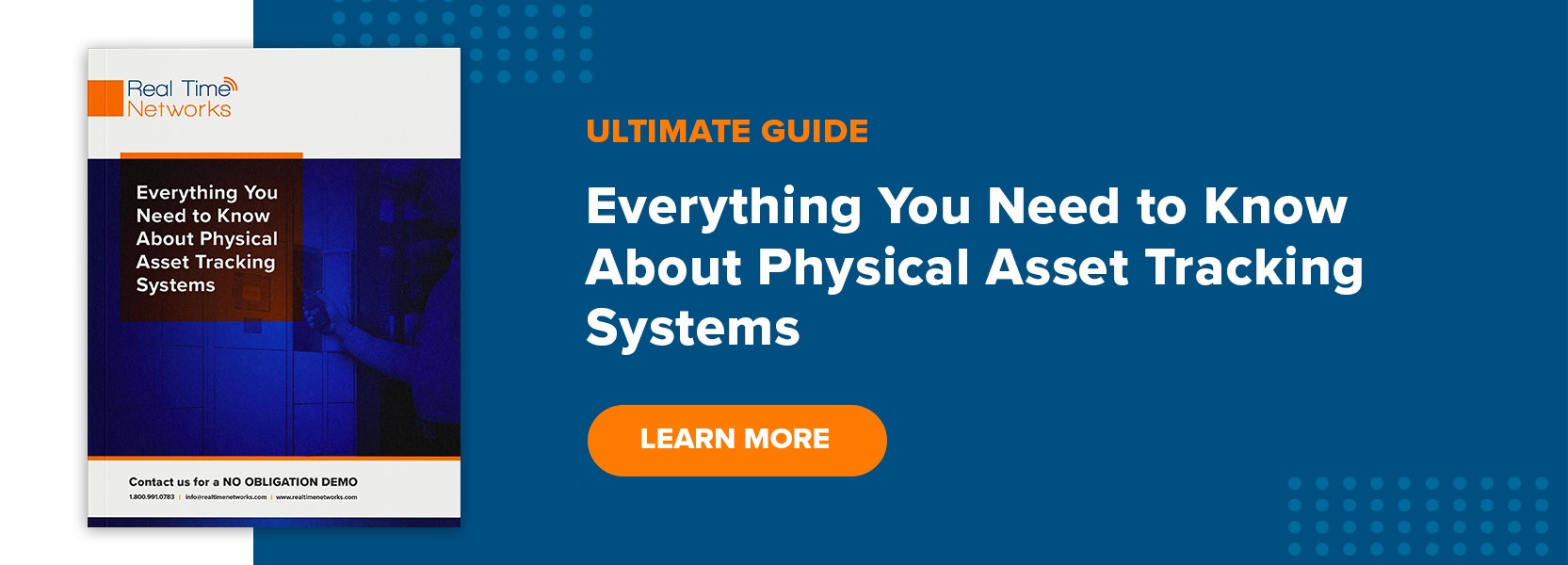By Jay Palter | May 11, 2022
Laptops, tablets, handheld scanners, and many other mobile devices have been commonplace business tools for decades now. During that time, many core business workflows have come to depend on the presence and usability of mobile electronics. They’re essential components of modern business, which means they need modern support, security, and management.
Everything’s connected. Whether it is a person, document, equipment kit, or a mobile device, your company's productivity will suffer if a business asset isn’t ready and available when you need it. Therefore, you need tools that automate and optimize how your people use your essential assets.
Smart lockers, sometimes called mobile device lockers, or laptop lockers, are one such tool, and many organizations are finding that they’re an effective solution to the problem of physically managing their mobile devices. This article explores how smart lockers work, how they can improve mobile device management, and some of the best practices you should follow for managing your mobile devices.
What Are Smart Mobile Device Lockers?
To understand smart lockers, you first need to understand smart technology more broadly. Smart technology is any piece of traditional business or consumer equipment that now carries an integrated computer and sensor network. That computer network can monitor, analyze, and change that device’s performance.
A smart locker is a storage system with just such an integrated network. These systems can monitor and control the devices you store in them. For example, you can control who signs out devices, how and when they’re allowed to return them, and set conditions on their use. You can also present users with customized checklists at signout and return so you have better control over the business processes within which your staff use mobile devices.
Smart lockers are also an effective business security tool, as, just like your mobile devices, they sit right at the critical cyber-physical security intersection. They provide real-time network-based monitoring and alerts for physical devices. And vice versa, layers of physical security for networked mobiles equipment.
Smart locker system components
Smart locker systems are composed of several key components that come together to become something greater than the sum of each part.
-
Storage Cabinets
Secure storage lockers are the foundation of a smart locker system. They come in modular configurations, so you can combine them to fit any number of devices you need to manage. They create a physical security check point where you can control who can access high-risk mobile assets.
-
Access Panel
An access control system is attached to the lockers—typically a smart panel touchscreen in modern, more advanced systems. This access panel authenticates users and allows you to control how they use your mobile devices.
For example, at a basic level, you can restrict which users can access which devices. Or you can only allow sign-outs at certain times of the day. Or set curfews on use, so staff members must return devices by a set time, or their supervisor will receive an alert.
You can also configure checklists that users must complete at sign-out or return before accessing the locker system. That helps you improve user accountability and offers quality control over how people use your devices. For example, you can require them to log all damage and software errors when they return a device before putting it back in circulation.
Smart lockers can use many different authentication methods. For lower security environments, PIN codes are often used. Higher security environments will either pair PIN codes with another form of authentication, like a swipe card, or use more secure credentials like biometrics.
-
Content Surveillance
Content surveillance refers to asset monitoring inside the locker system. Many devices charged over wired USB connections can also report their identity and status to the management system. So for example, a phone charging locker could verify whether a user plugged in a phone to charge for the next person when they recorded a return. And whether they even returned the same phone they signed out.
In addition, wireless RFID sensors inside locker compartments can scan tags on devices as users take or return them. That way, you can ensure that they don't accidentally or maliciously take the wrong devices.
-
Management Software
Access panel and content surveillance data flow back to central management software available on authorized desktop computers and mobile devices. You can monitor device usage in real time from the central software, manage users, and run reports. This central management provides insight and control over your devices not previously possible.
How Smart Lockers Improve Mobile Device Management and Security
Managing mobile devices can be a challenge. The right mobile device management locker system provides many benefits.
Cost-effective management
Mobile device lockers offer fully-automated transactions. That means no manual labor and faster operations. Staff members that were previously tied up with equipment management can now use their time doing more productive work.


Added accountability
Human error is an ever-present problem in manual business processes, including mobile device management. An automated system will always keep accurate records of who signed out which device, when they returned it, and what condition it was in.
Theft protection
Accidents and human error can happen. So too can theft. Despite what we might want to think, there are potential insider threats in every organization.
The added accountability, tracking, and deposit verification provided by content surveillance make smart lockers, like secure laptop lockers or phone lockers, an excellent tool for preventing the theft of your mobile devices. Those assets may be expensive, but they’re usually very replaceable. Instead, many users don’t consider the cost of downtime when those devices aren’t available for important and time-consuming work.
Enable new workflows
The smart technology embedded in locker systems automates routine work and also enables entirely new workflows, thanks to new capabilities provided by content surveillance sensors and the access panel interface. For example, employees can be required to log any damages when they deposit a handheld scanner or other mobile device. If they report something wrong, the locker system can send an automated alert to tech support and lock down the scanner, so no one else signs it out.

Automating regulatory compliance
The access controls and other security features in smart lockers help you ensure regulated devices and data are safe. And the transaction data collected by a smart locker system can help you meet many different reporting standards.
Best Practices for Mobile Device Physical Security
Using smart lockers to improve your mobile devices' physical security and management is a good start. Still, you can do many other things to improve how your organization protects your mobile devices. We think every organization should follow five best practices for mobile device physical security.
Train your staff
Workers are often the weakest link in a security program. Secure “the human factor” in your organization by training your staff on everything they need to know about device security and proper use.
Ensure your device security and management processes are included in new employee orientations. And offer regular training updates when you roll out new tools—like smart lockers—so everyone knows how to use them.
Create intake and disposals processes
If you don’t already have an updated inventory of all mobile devices in your organization, start by creating one. Then you need to ensure it stays current. Make sure every new device entering or leaving your organization gets added to your inventory.
Protect data
Remember, mobile devices sit at the cyber-physical security intersection. They’re valuable assets important to your workflows. They also hold valuable company data. Make sure you’re taking the necessary precautions to protect data-carrying mobile devices.
You might want to institute heightened security for devices carrying regulated customer or financial data. For example, using smart lockers that might mean setting sign-out curfews on sensitive devices, so supervisors know instantaneously if a user doesn’t return a device on schedule.
Use deterrents for better theft protection
Using smart panels to authenticate users is excellent protection against theft, but you need other defenses too. Look for ways to deter thieves before they get near your corporate mobile devices.
For example, you can configure some smart lockers to include cameras on their access panels that show users a recording of themselves as they sign out devices. Seeing a live recording can deter potential theft and fraud before a thief even tries accessing the system.
Have a theft response plan
Despite your best efforts, mobile devices will go missing. Create a response plan that details roles and responsibilities if a user reports a device lost or stolen.
Or don’t even wait for them to report it. Instead, trigger a response plan when a device is reported missing when a user doesn’t return it to the smart locker on curfew.
What does the person reporting the loss need to do? Who do they need to notify? What are the responsibilities of the owning department’s manager?
Mobile Device Security Protects Your Entire Organization
Mobile devices are essential components of many business workflows. They need the same security and management level that other essential assets get in a business environment. Smart lockers are just one excellent tool for automating mobile device security and management.

Want to see a mobile device locker in action?
Subscribe to our blog

Jay Palter
Vice President of Marketing & Partnerships





